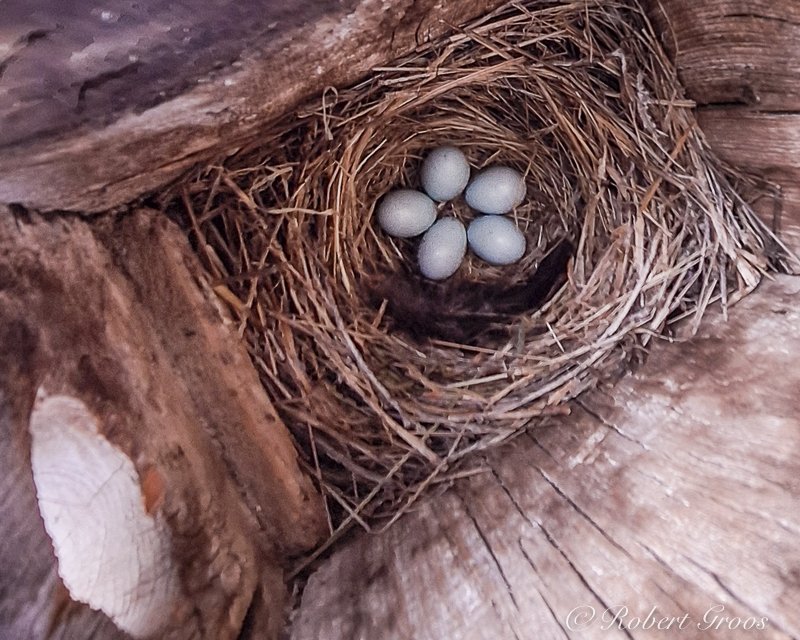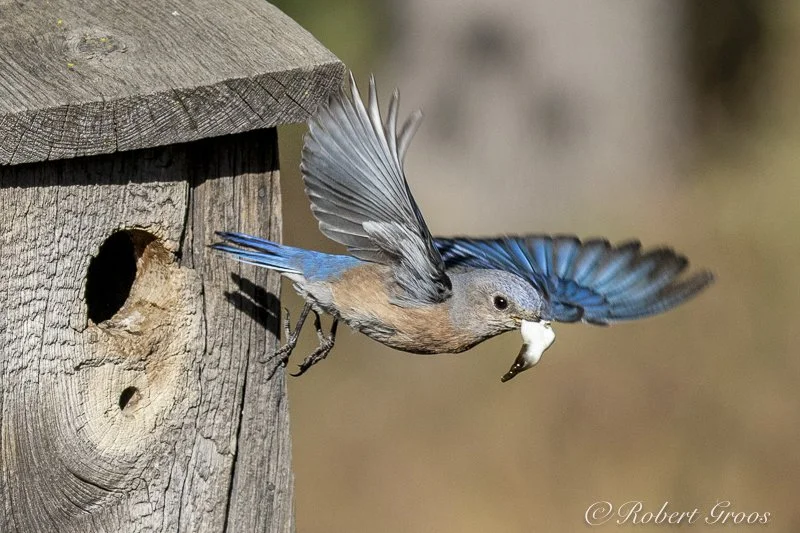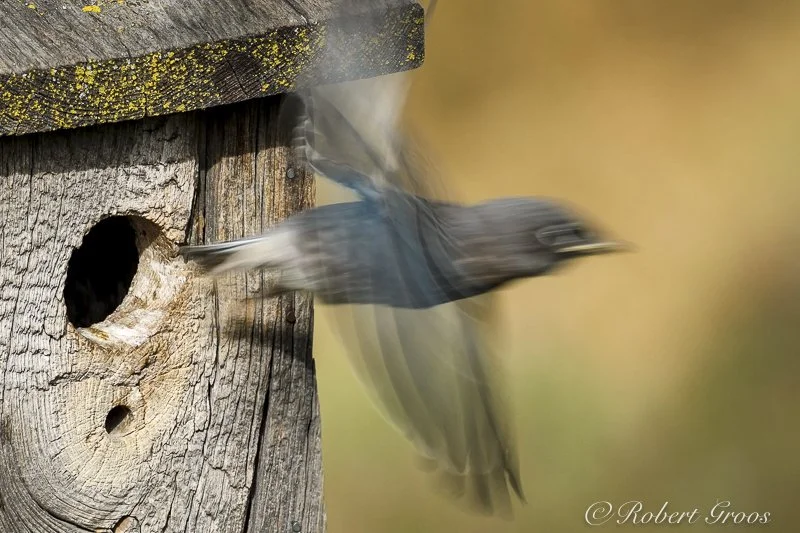Curiosity got the best of me one spring day.
An inner voice whispered: “Don’t do it.”
But I did.
I was curious as to why I had not been hearing Western Bluebird (Sialia mexicana) voices around my property. This time last year, mid-April, I was studiously observing the bluebird nest box I had installed in the shadow of a stately oak tree. Four chicks had hatched, and the adults were actively feeding them throughout the day, stuffing insects and worms down the gaping mouths of their offspring as fast as they could.
Female Western Bluebird with instect
The very hungry nestlings were rapidly gaining weight, and only a few weeks remained until they would fledge. You can read about them here.
This year, however, it was getting late in the season for a first brood, and I hadn’t seen any activity around the nest box. Curiosity told me to look inside that lonely nest box to see if there had even been the beginnings of nest building. I shouldered a short ladder and made my way down the slope to the oak tree where the nest box resided.
“Don’t do it,” I remember hearing again as I walked towards the nest box.
Truth be told, I really wasn’t expecting to see anything at this late date. Still, not knowing what, if anything, might be inside, I gingerly lifted the lid and cautiously peered inside for the briefest moment. Startled by what I saw, I quickly released the lid from my fingers. Oh my. What a surprise! I jumped to the ground, and dragging the ladder behind me, I ran away as fast as I could.
One year, that same box held the makings of a nest, abandoned by an Ash-throated Flycatcher. Included in its nest material was a piece of squirrel or rabbit tail, and that was quite a revelation. Now, to put your curiosity at rest, I’ll clarify that there was no animal fur of any kind in the box this year.
So why did I run away?
My inspection lasted no more than a couple of seconds. As I leaned over the opening, I saw a nest. It was loosely woven with long strands of grass. Whether it was finished or not, I couldn’t tell during the brief moment I peeked into the box. But there, occupying a good part of that little cup-shaped nest, was a pentagon of precious jewels: five blue eggs, symmetrically arranged like the petals of a flower. Western Bluebird eggs, to be exact.
Western Bluebird eggs
Unlike the eggs we purchase at the grocery, mass produced assembly line style by domestic chickens for consumption by humans looking for inexpensive protein, these were wild bird eggs. They represented a yet unfulfilled promise of reproductive success of the bluebird pair that formed a socially monogamous bond that might last successive years.
For the female, who selected a mate whose courtship behavior and richly colored plumage suggested maturity and reproductive fitness, then picked a nest site, wove a nest, laid five eggs over the course of five days, and incubated those eggs during the following two weeks, this clutch embodied an “all-in” gene sustaining investment.
When those five eggs hatch, her efforts to perpetuate her lineage will have only just begun. The next three weeks will be occupied by an ever increasing feeding frenzy as both parents search for and deliver greater amounts of various protein to their progeny. Ants, beetles, caterpillars, grasshoppers, wasps, even a worm or two will fill the bill of those hungry nestlings.
A female Western Bluebird feeds beetle to nestlings.
Necessarily, the more food delivered, the more nest sanitation is required. Fecal sacs (a natural membrane that encloses excretions) are removed after almost every feeding.
Female bluebird carrying fecal sac.
Even after the nestlings leave the box, free-flying fledglings may remain dependent upon parental care for several days. Hopefully, the food supply this spring will be close-by and plentiful, a key element leading to success of the breeding effort. A pentagon of eggs is a good sign that the female has confidence in the supply of insects this year.
From an abstract perspective, these bluebird eggs are symbolic of the freedom that biological evolution has bestowed upon birds as a species. Avian movement is not constrained by the weight and bulk of reproductive organs that function year-round, or the internal gestation of offspring, like mammals. They are, as a result, free to fly.
From time immemorial, birds have fascinated the human mind. Mythologies of cultures from around the world are replete with God birds who represent various powers and moral principles that inspire human thought and guide behavior: Quetzalcoatl (Aztec), Phoenix (Egypt, Greece), Roc (Middle East), Simurgh (Persia), Oden, (Norse), Horus (Egypt), and Fenghuang (Chinese) are just a few. And yet, for all that ornithology has done to demystify the principles of bird flight, the intricacies of avian plumage, and to explain the biology of their life history, the wonder and amazement we humans experience when observing birds never seems to diminish.
As for those beautiful blue eggs, that repository of a bluebird’s destiny, I could not put them out of my mind. They could hatch any time now. I had to have them, and soon.
Not to possess them physically, of course; their destiny did not belong to me. But to have a photo that would be with me in memory of this season, and the happiness with which those bluebirds filled my thoughts.
“Don’t do it,” that voice intoned once again.
The problem with taking a photograph was an ethical one. Unlike my uninformed, first visit to the nest box, I would now be knowingly taking the risk of disturbing the birds during a time most important in their life history. Would I listen this time?
“Don’t do it,” that voice whispered once more. But I did, and this is how, without disturbing the birds.
I had read a summary of scientific observations which detailed the frequency that an incubating female bluebird would leave her nest over the course of a set length of time. My own observations of this particular female over three days confirmed the same behavior and frequency as noted in those studies: she would be absent ten or fifteen minutes at a time.
With the bluebird away foraging, I could approach the nest, climb the ladder, lift the lid and take a photograph in less than two minutes, and then quickly be gone. And so I did.
I could not believe my good fortune in having discovered this bluebird nest, and the timing could not have been better. This stage in the nesting cycle would become the calendar anchor for my upcoming observations, because I knew that once those eggs hatched, the nestlings would be ready to fledge in approximately 17 to 21 days. Until then, I could do other things and wait for the real show to begin.
Like my bluebirds, I was “all in” on seeing this project to fruition. The previous year I witnessed two bluebird nestlings fledge, and made a video of that monumental moment in a bird’s life. It astonished me how fast it happened. Each bird disappeared in a mere second or so, as I showed in that post. If I had blinked, I would have missed it all.
Bluebird fledgling leaving nes
This year, in contrast, I planned to record that moment in slow motion in order to savor the overall action. My morning observations the day the nestlings left the nest went well. The lighting was beautiful; the chicks were aggressive, leaning far out of the hole begging for food, which the adults brought frequently.
Female Western Bluebird feeds nestlings video.
The thought came to me that the day’s mild weather compared to the wind and cold of the previous afternoon and evening would be the most likely time for the fledging to occur.
There was only one little snag in that scenario: I probably would not be here due to an appointment I made months earlier and which could not be easily rescheduled. I just knew that the nestlings would fledge while I was gone, and that is what they did.
When I returned home two hours later, the nest box environment had transformed: deep afternoon shade enveloped the scene; the chirping of baby birds was no more; and the chattering of adult bluebirds in the surrounding trees—calls of encouragement to the babies in the box—had gone still.
Cheerless nest box
That cheerless silence told me everything. My goal of making a slow motion video of the birds flying out of the box would not come to pass. Another twelve months would go by before I would have another opportunity, assuming the bluebirds returned to the nest box.
The jubilation of my morning’s anticipation evaporated as I stood there looking at the lonely nest box. Words cannot describe how despondent I felt, and the glum look across my countenance told the story of my sour mood.
I dismantled the photography blind and was packing up my gear when another voice spoke beside me. It sweetly tendered an infusion of sage advice:
“Why don’t you just go back outside and look for those bluebird babies in the trees?”
Those words, offered by my wife (whose suggestions I always heed), altered the gloominess of the moment. And so, in order to put some substance back into the several hours of observations I had already made, I spent the last of the afternoon light listening and looking for the baby bluebirds in the trees around my property.
But where to look, that was the question. It was their very first day in the wild, after all.
While watching the nest box activity before the nestlings spread their wings, I had noticed that the adults always flew in and back out on the same axis. Since that was the direction where the adults had been finding the food for their offspring, that’s where I would start looking. It seemed the logical place to go.
It was not long before I sighted those precious winged jewels. Adults and fledglings were here and there, going from tree branch to tree branch, and from tree branch to the ground. I captured photos as best I could, walking quickly from place to place. And then, the five fledglings assembled together on a single branch near where I was standing, surrounded by dense foliage. They fluttered and chirped and preened, and then flew away, all five of them.
Or, so I thought. In actuality, two remained—motionless—blending in with the leaves. Had I not taken a second look with binoculars I would have not known they were still there, sleeping. It’s no surprise they were tired, and needed a nap. They weren’t perched, either. Rather, they were lying on the branch that supported them. Such a unique and timely observation lifted my spirits anew.
Baby bluebirds sleeping on branch
While I did make several slow motion clips of the adult bluebirds flying to and from the nest box, the brass ring to have grabbed would have been, of course, slow motion videos of baby bluebirds leaving the nest, since that was my defined goal. It was an elusive objective that, in retrospect, wrongfully overshadowed the wonderful discoveries I made during this year’s watch.
There were, for example, three surprise visitors to that nest box, and probably more that came when I was not there. What did that little Oak Titmouse think while clinging to the side of the nest box with nestlings chirping inside? Likewise, the Ash-throated Flycatcher when it looked inside the nest box opening: a potential nest site for it one day, perhaps? And what about the predation-minded scrub jay, intent on snacking upon fresh nestling meat, that tried to wiggle its large frame into the smaller bluebird-sized box hole? See photos in the gallery below.
Above all, I witnessed an important evolutionary behavior designed to assure the survival of bluebird nestlings, a behavior that I had read about but never seen. For Western Bluebirds, family entails an important obligation: it is not uncommon for an unmated male that hatched the previous year to help its parents with the feeding of its newest siblings.
But how could an observer know if the male bluebird feeding a nestling was the father or the son? They both look alike. Remarkably, this year, I watched it happen without any doubt when, on multiple occasions two male bluebirds were present at the nest box simultaneously. Thankfully, I was able to record the action, as captured in slow motion, below.
Two male bluebirds followed by a female feeding nestlings video
As for the baby bluebirds, I saw them only that one afternoon. Henceforth, they blended into the landscape of my patch in the Sierra foothills where I make my home, south of Yosemite National Park. But the memory of their hatching (and a photo of their eggs) resonates with deep satisfaction of time well spent.
Bluebird eggs
If you enjoyed this post, please share the link with your friends. To be added to my mailing list for future articles, contact me at: robertgroos1@gmail.com. Your information will not be shared, and you can unsubscribe at anytime. Thank you.

















